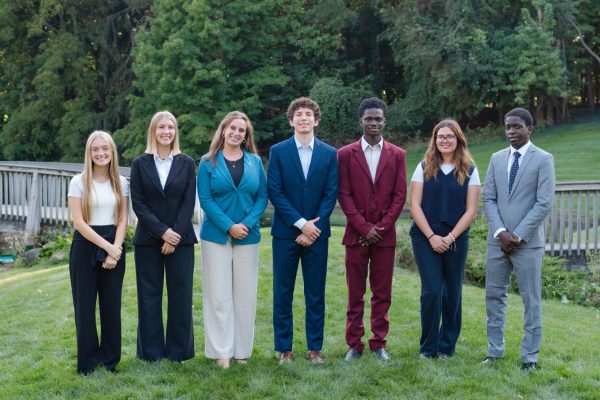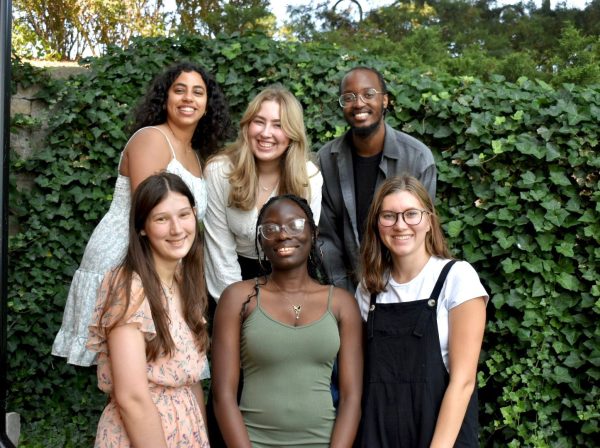Higher retention balances smaller incoming class
Incoming students participate Street Fest as part of Quest. This year’s incoming class was small than in previous years. Photo Courtesy Calvin College Facebook page.
Calvin is once again welcoming a smaller incoming class to campus this fall, though retention of students from last year’s incoming class rose enough to compensate.
This year’s class includes 889 first-time college students (FTIACs), down from 909 in 2016, according to the Day 10 enrollment report. Meanwhile, the percentage of students returning for their second year has increased from 84.6 percent to 86.7 percent.
While the overall FTIAC enrollment number fell short of the budgeted goal of 910, the gains in retention made up the difference, said Sally Vander Ploeg, vice president for administration and finance. The total number of full-time equivalent students, 3,559, is slightly above the number used to plan this year’s budget.
The percentages of FTIACs who are CRC members, children of alumni and graduates of Christian high schools all fell this year, continuing trends seen in the last decade. Only 27.2 percent of this year’s incoming class belongs to the CRC. Five years ago in 2012, that figure was 38.7 percent.
In contrast, the percentages of ethnic minority (AHANA) and international students both increased. AHANA students make up 16.3 percent of this year’s first-year class, up from 14.6 percent last year, and international students make up 14.2 percent, up from 12.4 percent.
While these numbers show growth among Calvin’s minority student populations, Ben Arendt, director of admissions, warns against reading these numbers as signs of improved diversity and inclusion on their own:
“People want to jump to the number,” Arendt said. “Let’s say we have a record number of AHANA students only to have more students experience structural racism. That isn’t our goal.”
Arendt hopes that valuing diversity and inclusion will be an integral part of the entire recruitment progress:
“It just infuses into the work we do — the types of high schools we visit, the college fairs we seek out, the events we do.”
Although the percentage of admitted students who decided to attend Calvin increased this year, the total number of admitted students decreased by nearly 300.
According to Arendt, that drop in admitted students is due in part to Calvin using the Common Application exclusively last year instead of offering a shorter Calvin-only application as well.
For the next recruitment year, Arendt said, Calvin is bringing back a Calvin-specific application alongside the Common Application.
Thanks to Calvin’s new constituent relationship management (CRM) system, the application is pre-populated with all the information Calvin already has about an applicant so that it’s easier to complete.
As of Sept. 14, applications for 2018’s incoming class were up 50 percent from this time last year, said Russ Bloem, vice president for enrollment management.
Calvin’s retention rate used to hover around 87-88 percent, said Todd Dornbos, director of retention, but after a recent drop-off, Calvin began working hard to increase those numbers in fall 2015.
Much of that initiative included improving the resources and support available to students during their first year at Calvin.
In addition, the Access Scholars program for conditionally admitted students hired a new staff member to teach academic support classes, and the minimum GPA requirement for scholarships was lowered to 3.0.
While the overall retention rate increased by 2.1 percentage points, the gains were much higher among the populations who are most likely to leave Calvin. Retention among AHANA and first-time college students, for example, increased by 9.1 and 10.3 percentage points respectively.
Among groups with traditionally high retention, such as top scholarship recipients and Christian high school graduates, retention held steady this year, Dornbos said.
He added that both these results are encouraging:
“We want to preserve good retention rates with our populations that traditionally do well, but we want to do everything we can to ensure that our other populations have just as good a chance to succeed.”
“We can’t think about admissions without also ensuring that we’re doing everything we can to make sure every student that’s admitted has a great chance for success,” Dornbos said.
Bloem said that students list interactions with Calvin professors and students as the most important factors in their decision to attend Calvin, and both Arendt and Dornbos stressed the role of the whole campus — from professors to resident directors to fellow students — in attracting and keeping students.
“Enrollment doesn’t write the story,” Arendt said. “We tell the story.”










